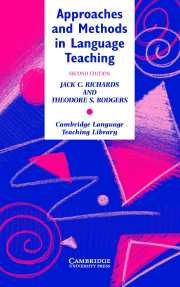Book contents
- Frontmatter
- Contents
- Preface
- Part I Major language trends in twentieth-century language teaching
- Part II Alternative approaches and methods
- Part III Current communicative approaches
- 14 Communicative Language Teaching
- 15 The Natural Approach
- 16 Cooperative Language Learning
- 17 Content-Based Instruction
- 18 Task-Based Language Teaching
- 19 The post-methods era
- Author index
- Subject index
15 - The Natural Approach
Published online by Cambridge University Press: 06 July 2010
- Frontmatter
- Contents
- Preface
- Part I Major language trends in twentieth-century language teaching
- Part II Alternative approaches and methods
- Part III Current communicative approaches
- 14 Communicative Language Teaching
- 15 The Natural Approach
- 16 Cooperative Language Learning
- 17 Content-Based Instruction
- 18 Task-Based Language Teaching
- 19 The post-methods era
- Author index
- Subject index
Summary
Background
In 1977, Tracy Terrell, a teacher of Spanish in California, outlined “a proposal for a ‘new’ philosophy of language teaching which [he] called the Natural Approach” (Terrell 1977; 1982: 121). This was an attempt to develop a language teaching proposal that incorporated the “naturalistic” principles researchers had identified in studies of second language acquisition. The Natural Approach grew out of Terrell's experiences teaching Spanish classes, although it has also been used in elementary- to advanced-level classes and with several other languages. At the same time, he joined forces with Stephen Krashen, an applied linguist at the University of Southern California, in elaborating a theoretical rationale for the Natural Approach, drawing on Krashen's influential theory of second language acquisition. Krashen and Terrell's combined statement of the principles and practices of the Natural Approach appeared in their book The Natural Approach, published in 1983. The Natural Approach attracted a wider interest than some of the other innovative language teaching proposals discussed in this book, largely because of its support by Krashen. Krashen and Terrell's book contains theoretical sections prepared by Krashen that outline his views on second language acquisition (Krashen 1981; 1982), and sections on implementation and classroom procedures, prepared largely by Terrell.
Krashen and Terrell identified the Natural Approach with what they call “traditional” approaches to language teaching. Traditional approaches are defined as “based on the use of language in communicative situations without recourse to the native language” – and, perhaps, needless to say, without reference to grammatical analysis, grammatical drilling, or a particular theory of grammar.
Information
- Type
- Chapter
- Information
- Approaches and Methods in Language Teaching , pp. 178 - 191Publisher: Cambridge University PressPrint publication year: 2001
Accessibility standard: Unknown
Why this information is here
This section outlines the accessibility features of this content - including support for screen readers, full keyboard navigation and high-contrast display options. This may not be relevant for you.Accessibility Information
- 1
- Cited by
